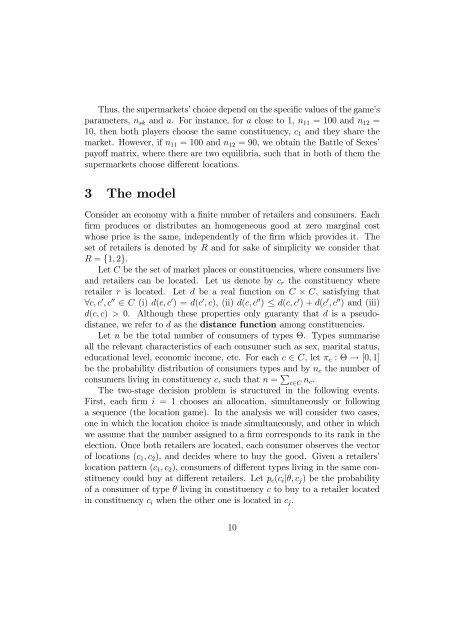Download PDF - Ivie
You also want an ePaper? Increase the reach of your titles
YUMPU automatically turns print PDFs into web optimized ePapers that Google loves.
Thus, the supermarkets’ choice depend on the specific values of the game’s<br />
parameters, n sk and a. For instance, for a close to 1, n 11 = 100 and n 12 =<br />
10, then both players choose the same constituency, c 1 and they share the<br />
market. However, if n 11 = 100 and n 12 = 90, we obtain the Battle of Sexes’<br />
payoff matrix, where there are two equilibria, such that in both of them the<br />
supermarkets choose different locations.<br />
3 The model<br />
Consider an economy with a finite number of retailers and consumers. Each<br />
firm produces or distributes an homogeneous good at zero marginal cost<br />
whose price is the same, independently of the firm which provides it. The<br />
set of retailers is denoted by R and for sake of simplicity we consider that<br />
R = {1, 2}.<br />
Let C be the set of market places or constituencies, where consumers live<br />
and retailers can be located. Let us denote by c r the constituency where<br />
retailer r is located. Let d be a real function on C × C, satisfying that<br />
∀c, c ,c ∈ C (i) d(c, c )=d(c ,c), (ii) d(c, c ) ≤ d(c, c )+d(c ,c )and(iii)<br />
d(c, c) > 0. Although these properties only guaranty that d is a pseudodistance,<br />
we refer to d as the distance function among constituencies.<br />
Let n be the total number of consumers of types Θ. Types summarise<br />
all the relevant characteristics of each consumer such as sex, marital status,<br />
educational level, economic income, etc. For each c ∈ C, letπ c : Θ → [0, 1]<br />
be the probability distribution of consumers types and by n c the number of<br />
consumers living in constituency c, such that n = c∈C n c.<br />
The two-stage decision problem is structured in the following events.<br />
First, each firm i = 1 chooses an allocation, simultaneously or following<br />
a sequence (the location game). In the analysis we will consider two cases,<br />
oneinwhichthelocationchoiceismade simultaneously, and other in which<br />
we assume that the number assigned to a firm corresponds to its rank in the<br />
election. Once both retailers are located, each consumer observes the vector<br />
of locations (c 1 ,c 2 ), and decides where to buy the good. Given a retailers’<br />
location pattern (c 1 ,c 2 ), consumers of different types living in the same constituency<br />
could buy at different retailers. Let p c (c i |θ,c j ) be the probability<br />
of a consumer of type θ living in constituency c to buy to a retailer located<br />
in constituency c i when the other one is located in c j .<br />
10
















